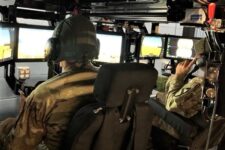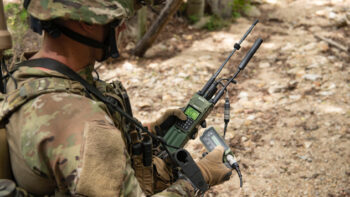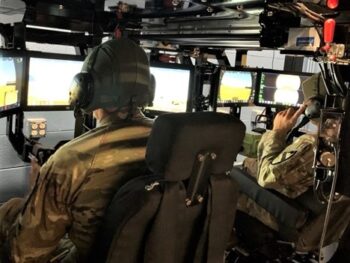
A soldier deposits funds into a safe in a finance office, Nov. 4, 2013, at Bagram Air Field, Parwan province, Afghanistan. (U.S. Army Sgt. Sinthia Rosario, Task Force Lifeliner Public Affairs)
WASHINGTON — The Pentagon’s Office of Strategic Capital (OSC), tasked with linking smaller tech and defense firms with sources of private capital, plans to come out with its first investment strategy later this year targeting what it has identified as critical technology areas, including artificial intelligence, biotechnology and quantum science.
“So one of the first things that the secretary asked in our establishment memo was to build an investment strategy that takes and prioritizes our critical technology areas, our areas where we think OSC tools, these tools like loans can be the most effective at increasing private capital investment,” OSC Director Jason Rathje said today at the Defense News conference. “And we hope to have that out sometime in the next few months.”
Rathje added that OSC is “looking across key industries” within those critical technology areas beyond the tech itself.
“We’re focused on not only the core technology, but the companies and industries that comprise that, both in the areas that are kind of more closer to the department… artificial intelligence for autonomy, for example, but also in areas that are deep within the supply chain, like semiconductors,” he said.
RELATED: For emerging tech, DoD funds $100M in new projects to help bridge ‘valley of death’
OSC was established last December to help provide long-term funds aimed at bridging the “valley of death” where promising technologies fail to survive the sometimes pricey shift from the lab to the field.
The investment strategy for OSC will be reviewed by a strategic capital advisory council co-chaired by several DoD offices, including the undersecretary of defense for research and engineering, acquisition and sustainment, the cost assessment and program evaluation office, comptroller, policy, service acquisition executives and the J8, the Joint Chiefs of Staff’s capabilities directorate.
Rathje said the first meeting with the council is slated to take place this month, where they’ll be looking at the progress to date that the office has made and the areas in which the office wants to invest.
“Although when we are looking at investing in areas like metamaterials or carbon nanotubes or MEMS [microelectromechanical systems] devices, [it] doesn’t mean we don’t want to make sure that those priorities are connected back to DoD, both at OSD and within the services,” Rathje said.
“And so as we learn more about what these technologies can actually provide, even though that they are commercial enabling technologies… those capabilities need to be included in requirements, planning decisions and programming decisions because we’ll learn more about what is available in the commercial market, because we’ll be part of that journey from the very beginning.”
Rathje added that the DoD portion of its first program activity called the Small Business Investment Company (SBIC) critical technologies initiative will be rolling out “in the next few weeks.” In February, he said the office would start taking applications for the initiative this summer and wanted to “license our first funds” for the program later this year, saying SBIC would help the office identify what technology areas most require capital.
“Now the way this program works is it leverages what is called the Federal Credit Program… where other departments and agencies utilize government loans and loan guarantees to increase leveraging technology areas and societal sectors that we think are important to increase investment in,” he said February 1.
DISA grapples with mounting ‘technology debt’ amid evolving cyber threats
“We need to make sure that technical debt is not pre-framed as just cost. There’s a lot more that comes with technical debt. There’s people, there’s operational aspect, there’s efficiencies,” warned Caroline Bean, director of joint enterprise services at DISA.



























